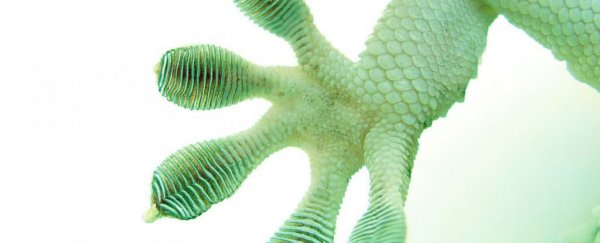Spider-Man's ability to scale vertical walls may help the web-slinger catch the bad guys in comic books, but he could never pull this trick off in reality, according to scientists in the UK.
A new study by zoologists at the University of Cambridge has found that geckos are the largest animals capable of sticking to smooth vertical surfaces – an ability that requires increasingly larger adhesive footpads as a percentage of overall body surface as animals themselves become bigger.
"As animals increase in size, the amount of body surface area per volume decreases – an ant has a lot of surface area and very little volume, and an elephant is mostly volume with not much surface area," said one of the researchers, David Labonte.
"This poses a problem for larger climbing animals because, when they are bigger and heavier, they need more sticking power, but they have comparatively less body surface available for sticky footpads. This implies that there is a maximum size for animals climbing with sticky footpads – and that turns out to be about the size of a gecko."
The researchers compared the weight and footpad size of 225 climbing animal species. From the smallest (mites) to the largest (geckos) that use adhesion to stick to surfaces, this range of species spans more than seven orders of magnitude in weight – which, as Labonte points out, is like comparing the weight of a cockroach to that of Big Ben.
And that massive difference in weight is why the size of adhesive pads in small and large animals varies so widely. Tiny mites, for example, use approximately 200 times less of their total body area for sticky pads than geckos – the unofficial Big Ben of the adhesive climbing animal world – do. You can see a comparison of this in some species in the image below:
 David Labonte
David Labonte
Larger animals would be able to climb vertical walls by adhesion if they surrendered more body surface area to sticky footpads, but the necessary morphological changes would make the evolution of such traits impractical, according to the researchers.
"If a human, for example, wanted to walk up a wall the way a gecko does, we'd need impractically large sticky feet – our shoes would need to be a European size 145 or a US size 114," said one of the team, Walter Federle
In terms of body surface area, this would entail 40 percent of our bodies – or 80 percent of our front side, if we were basically human slugs – to be covered in sticky pads. Hmm, on second thoughts… cancel that body modification op.
The findings, to be published in PNAS, could have implications for the development of manufacturing powerful human-made adhesives on a large scale, using the sticky pads of the animal world as a blueprint.
"Adhesive pads of climbing animals are a prime example of convergent evolution – where multiple species have independently, through very different evolutionary histories, arrived at the same solution to a problem," said Labonte. "When this happens, it's a clear sign that it must be a very good solution."
